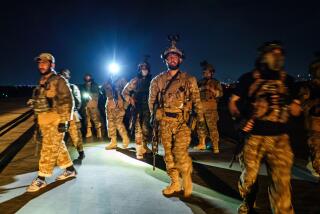Key Afghan town still at risk, U.S. general says
- Share via
The safety situation for Afghan villagers remains precarious in Marja, where U.S. Marines and Afghan soldiers mounted a massive assault in February to oust the Taliban from control, the Marine general who led the assault said late Sunday.
Speaking by telephone to reporters in the U.S., Brig. Gen. Larry Nicholson said that while there are hopeful signs in Marja -- schools reopening, Afghan police patrolling, farmers signing up to grow crops other than opium poppy -- it will be months before the Marja mission can be considered a success.
“It’s still a fragile security situation,” Nicholson said. “ÃÂ I think we’re off to a good start, but the success or failure of Marja will be determined in the next six months.”
Helmand Province Gov. Mohammad Gulab Mangal, speaking after Nicholson, said Taliban fighters continue to threaten residents of Marja.
“They are using the local civilians as targets,” he said. “It is very important that we take care of the local civilians.”
Two Marine battalions remain in Marja along with Afghan security forces. But insurgents continue to plant roadside bombs in hopes of killing Marines and to intimidate civilians by visiting their homes at night.
Until February’s assault, Marja, a collection of farming communities, was considered a Taliban sanctuary. Marja is thick with poppy fields, providing the substance that makes heroin; drug profits help fund the Taliban.
With Marines in the forefront, thousands of U.S. and Afghan troops swept across the area in February, engaging in dozens of prolonged firefights with Taliban fighters barricaded inside houses and hiding in irrigation canals. A dozen Marines were killed, along with several hundred Taliban fighters.
Once the shooting stopped, the U.S. shifted into a counterinsurgency strategy that emphasizes winning the support of civilians by strengthening the presence of their local and national government.
For the battle of Marja to influence the overall struggle for control of Afghanistan, the U.S. and Afghan governments will have to move quickly to improve the lot of its citizens, officials have long conceded. The residents of Marja appear more suspicious of the U.S. motives and constancy.
Before the Taliban took control, government in Marja was known as weak and corrupt. As a result, Marja residents are skeptical to the point of hostile toward the provincial government in Lashkagar and the national government in Kabul.
“Right now, it’s pretty thin,” Nicholson said of the governmental presence in Marja. “We need to do more. ÃÂ A better test will be 90 days from now, six months from now.”
The Taliban, while brutal in its methods, brought a measure of rough justice to Marja that allowed disputes to be settled. The U.S. is pressuring the Afghan government to establish a court system in Marja and the rest of Helmand province.
“It’s the one thing that the Taliban has been able to provide that we haven’t: immediate rule of law,” Nicholson said.
Nicholson’s comments came just hours before a formal ceremony at Camp Leatherneck, where he relinquished command after a year of being in charge of all Marines in Afghanistan. Under Nicholson, Marines wrested control of several villages in central Helmand province from the Taliban and assisted efforts to establish civilian governments.
Under the “surge” approved by President Obama, the number of Marines is nearly doubling to 19,000. Nicholson’s successor, Maj. Gen. Richard Mills, said Marines will be able to expand their presence.
“We’re going to push the insurgency in places that have not been cleaned,” Mills told reporters.
Nicholson is set to return to the U.S. within days. He said he is eager to see his family and to visit with wounded and injured Marines.
In the last 12 months in Afghanistan, 85 Marines have been killed and 877 wounded in action.
“Any success we’ve had in Helmand, we’ve paid a pretty high price,” he said.
More to Read
Sign up for Essential California
The most important California stories and recommendations in your inbox every morning.
You may occasionally receive promotional content from the Los Angeles Times.













